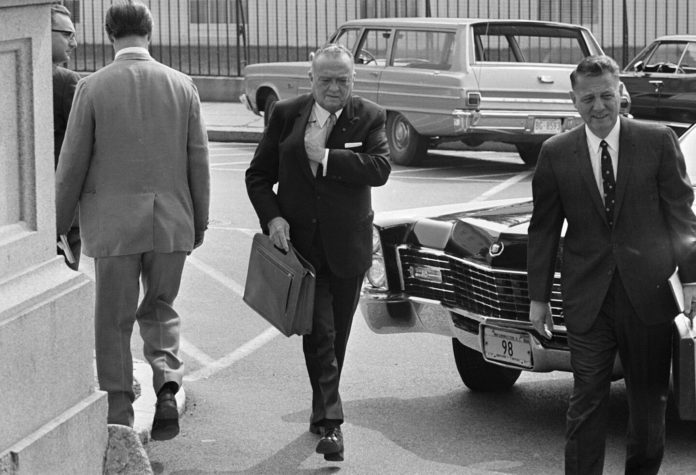
Kirchick’s “Secret City” runs chronologically, spanning from approximately 1940 to 1999; more specifically, the narrative is organized by presidential administrations, with each of the 11 sections bearing the name of a corresponding White House occupant, from Franklin Roosevelt to Bill Clinton. Apart from notable appearances by a handful of otherwise underexplored gay and lesbian politicos — scrappy CIA officer Carmel Offie, Office of Strategic Services trailblazer Cora Du Bois and Kennedy confidant Lem Billings, among others — “Secret City” largely focuses on the pain experienced by, and at the hands of, familiar gay men like FBI Director J. Edgar Hoover (who Kirchick curiously avoids identifying as homosexual), McCarthyite and Trump mentor Roy Cohn, and infamous New Right lobbyist Terry Dolan. Most gay voices, however, are drowned out by, even treated as less credible than, those of homophobic straight people: Gossip columnists, yellow journalists, embattled presidents, conniving senators, obsequious FBI agents and a rotating cast of aides all are relied upon as primary sources in a history that is not primarily theirs to tell. Kirchick promises to show us “the wide-ranging influence of homosexuality on the nation’s capital, on the people who dwelled within it, and on the weighty matters of state they conducted.” But “Secret City” might more accurately be described as a surface-level glimpse at the prominence of homophobia in the federal government and the D.C. press corps, how such homophobia has long manifested as rumor and innuendo (pages and pages of which are here reproduced), the influence of such homophobia on an enormous cast of almost exclusively White gay men, and how more than a few of those men played not-insignificant roles in the GOP’s long march to the far right.
These are not unimportant topics. Gay history, after all, is older and bigger than one riot, one protest or one ideology, and we should always welcome stories that unsettle popular narratives. At the same time, however, those seeking to unsettle such narratives should strive for the transparency and accountability so often lacking in older histories. And it’s here where “Secret City” falters. In 43 chapters and more than 650 pages of text, Kirchick rarely ventures beyond the federal government’s highest echelons, all but ignoring the fact that both the government and the District of Columbia are much bigger than whichever administration happens to be in town. Following the example of many of those featured in its pages, “Secret City” falls back on policies of the past to justify the exclusion of those harmed by such policies. That is, because “weighty matters of state” have historically been conducted in rooms filled almost entirely by White men, Kirchick seems content not to ask questions about those waiting outside.
Unlike earlier “secret cities,” Kirchick’s says next to nothing about Black Washington. (Two Black people, Odessa Madre and Bayard Rustin, are given a combined total of 17 pages.) And yet, despite the lack of attention, the author doesn’t hesitate to make sweeping assertions. At one point, for example, Kirchick attributes a “lack of Black participation” in an early gay rights organization, at least in part, “to the fact that Washington’s Black residents were mostly locals … and associating with a gay organization was significantly harder while living in the city where one’s family resided.” This claim, however, flies in the face of even the quickest glance at Black gay life, to say nothing of the many D.C.-specific histories that demonstrate how queerness rarely disrupted Black Washington’s powerful family ties. Similarly, while “Secret City” has little to say about lesbians, the author attempts to explain the silence away with questionable, and ultimately unsustainable, declarations of how “persecution generally targeted male homosexuals more severely than female ones, a consequence, in part, of patriarchal attitudes privileging men over women.” Because society places less value on women, the argument goes, it is therefore more difficult to be a man.
Many of the book’s weaknesses are attributable to Kirchick’s apparent aversion to common-sense conventions of language. Readers might struggle to stay invested in a narrative weighted down by laborious vocabulary such as “hirsute” (hairy), “farrago” (hodgepodge) and “bromidic” (trite). Likewise, many undoubtedly will wonder how and why the author never uses the word “transgender” yet still manages to include the most vile of racial slurs multiple times, albeit under cover of quotation marks. (Elsewhere, the quotation marks and any corresponding citations disappear, giving the impression that Kirchick himself is describing disabled Founding Father Gouverneur Morris as “peg-legged,” a (fictional) character as “Negro-loving” or Black activists as “uppity.”) There are other mystifying descriptions, like that of Whitaker Chambers, who, Kirchick writes, “was (at least for a time) a homosexual.” This, of course, is not how homosexuality works. Equally troubling is the book’s uneven approach to the complicated politics of “the closet,” lurching without warning from requisite portrayals of survival-by-secrecy to describing, in language both hackneyed and harmful, the nine gay victims of D.C.’s Cinema Follies fire as having been “trapped inside their self-imposed chambers of deceit.”
For many of us who study the queer past, there’s an always-present need to articulate the joys found amid the difficult realities of those who came before, those who made life possible. But there’s no reality in conflating homophobia with homosexuality, there’s no joy in confusing the difficult with the tragic, the ignored with the secret. In a 1967 review of Constance Green’s “The Secret City,” Professor George R. Woolfolk drew a conclusion that applies with equal force to Kirchick’s book. Green’s work, Woolfolk wrote, “called for as much creative sociology as it did definitive history. Unfortunately it is short on both.”
Matthew L. Riemer is a co-author of “We Are Everywhere: Protest, Power, and Pride in the History of Queer Liberation” and a co-creator of the online resource @lgbt_history.
Secret City
The Hidden History of Gay Washington
By James Kirchick
Henry Holt. 826 pp. $38







